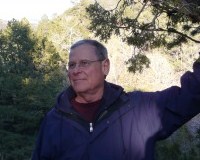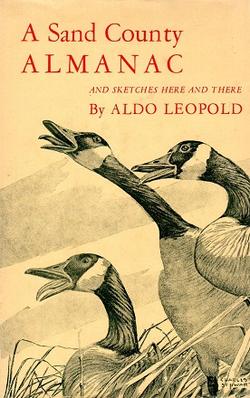
Human ecology is an interdisciplinary and transdisciplinary study of the relationship between humans and their natural, social, and built environments. The philosophy and study of human ecology has a diffuse history with advancements in ecology, geography, sociology, psychology, anthropology, zoology, epidemiology, public health, and home economics, among others.
In environmental philosophy, environmental ethics is an established field of practical philosophy "which reconstructs the essential types of argumentation that can be made for protecting natural entities and the sustainable use of natural resources." The main competing paradigms are anthropocentrism, physiocentrism, and theocentrism. Environmental ethics exerts influence on a large range of disciplines including environmental law, environmental sociology, ecotheology, ecological economics, ecology and environmental geography.
A land ethic is a philosophy or theoretical framework about how, ethically, humans should regard the land. The term was coined by Aldo Leopold (1887–1948) in his A Sand County Almanac (1949), a classic text of the environmental movement. There he argues that there is a critical need for a "new ethic", an "ethic dealing with human's relation to land and to the animals and plants which grow upon it".

Aldo Leopold was an American writer, philosopher, naturalist, scientist, ecologist, forester, conservationist, and environmentalist. He was a professor at the University of Wisconsin and is best known for his book A Sand County Almanac (1949), which has been translated into fourteen languages and has sold more than two million copies.

Habitat conservation is a management practice that seeks to conserve, protect and restore habitats and prevent species extinction, fragmentation or reduction in range. It is a priority of many groups that cannot be easily characterized in terms of any one ideology.

The tallgrass prairie is an ecosystem native to central North America. Historically, natural and anthropogenic fire, as well as grazing by large mammals provided periodic disturbances to these ecosystems, limiting the encroachment of trees, recycling soil nutrients, and facilitating seed dispersal and germination. Prior to widespread use of the steel plow, which enabled large scale conversion to agricultural land use, tallgrass prairies extended throughout the American Midwest and smaller portions of southern central Canada, from the transitional ecotones out of eastern North American forests, west to a climatic threshold based on precipitation and soils, to the southern reaches of the Flint Hills in Oklahoma, to a transition into forest in Manitoba.

Applied ecology is a sub-field within ecology that considers the application of the science of ecology to real-world questions. It is also described as a scientific field that focuses on the application of concepts, theories, models, or methods of fundamental ecology to environmental problems.

J. Baird Callicott is an American philosopher whose work has been at the forefront of the new field of environmental philosophy and ethics. He is a University Distinguished Research Professor and a member of the Department of Philosophy and Religion Studies and the Institute of Applied Sciences at the University of North Texas. Callicott held the position of Professor of Philosophy and Natural Resources at the University of Wisconsin–Stevens Point from 1969 to 1995, where he taught the world's first course in environmental ethics in 1971. From 1994 to 2000, he served as vice president then president of the International Society for Environmental Ethics. Other distinguished positions include visiting professor of philosophy at Yale University; the University of California, Santa Barbara; the University of Hawaiʻi; and the University of Florida.

Ecological engineering uses ecology and engineering to predict, design, construct or restore, and manage ecosystems that integrate "human society with its natural environment for the benefit of both".

Ecological restoration is the process of assisting the recovery of an ecosystem that has been degraded, damaged, or destroyed. It is distinct from conservation in that it attempts to retroactively repair already damaged ecosystems rather than take preventative measures. Ecological restoration can reverse biodiversity loss, combat climate change, and support local economies. The United Nations named 2021-2030 the Decade on Ecosystem Restoration.
Ecocentrism is a term used by environmental philosophers and ecologists to denote a nature-centered, as opposed to human-centered, system of values. The justification for ecocentrism usually consists in an ontological belief and subsequent ethical claim. The ontological belief denies that there are any existential divisions between human and non-human nature sufficient to claim that humans are either (a) the sole bearers of intrinsic value or (b) possess greater intrinsic value than non-human nature. Thus the subsequent ethical claim is for an equality of intrinsic value across human and non-human nature, or biospherical egalitarianism.

Wildlife management is the management process influencing interactions among and between wildlife, its habitats and people to achieve predefined impacts. It attempts to balance the needs of wildlife with the needs of people using the best available science. Wildlife management can include wildlife conservation, gamekeeping and pest control. Wildlife management draws on disciplines such as mathematics, chemistry, biology, ecology, climatology and geography to gain the best results.

The University of Wisconsin–Madison Arboretum is a teaching and research facility of the University of Wisconsin–Madison and the site of historic research in ecological restoration. In addition to its 1,260 acres (5 km2) in Madison, Wisconsin, the Arboretum also manages 520 acres (210 ha) of remnant forests and prairies throughout Wisconsin. It was designated a National Historic Landmark in 2021, in recognition for its role as a pioneer in the field of ecological restoration.

A Sand County Almanac: And Sketches Here and There is a 1949 non-fiction book by American ecologist, forester, and environmentalist Aldo Leopold. Describing the land around the author's home in Sauk County, Wisconsin, the collection of essays advocate Leopold's idea of a "land ethic", or a responsible relationship existing between people and the land they inhabit. Edited and published by his son, Luna, a year after Leopold's death, the book is considered a landmark in the American conservation movement.
In environmental philosophy, ecological self is central to the school of Experiential Deep Ecology, which, based on the work of Norwegian philosopher Arne Næss, argues that through the process of self-actualisation, one transcends the notions of the individuated "egoic" self and arrives at a position of an ecological self. So long as one is working within the narrower concept of self, Næss argues, environmentally responsible behaviour is a form of altruism, a "doing good for the other", which historically has been a precarious ethical basis, usually involved in exhorting others to "be good". Næss argues that in his Ecosophy, the enlargement of the ego-self to the eco-self results in environmentally responsible behaviour as a form of self-interest.

Ecosystem health is a metaphor used to describe the condition of an ecosystem. Ecosystem condition can vary as a result of fire, flooding, drought, extinctions, invasive species, climate change, mining, fishing, farming or logging, chemical spills, and a host of other reasons. There is no universally accepted benchmark for a healthy ecosystem, rather the apparent health status of an ecosystem can vary depending upon which health metrics are employed in judging it and which societal aspirations are driving the assessment. Advocates of the health metaphor argue for its simplicity as a communication tool. "Policy-makers and the public need simple, understandable concepts like health." Some critics worry that ecosystem health, a "value-laden construct", can be "passed off as science to unsuspecting policy makers and the public." However, this term is often used in portraying the state of ecosystems worldwide and in conservation and management. For example, scientific journals and the UN often use the terms planetary and ecosystem health, such as the recent journal The Lancet Planetary Health.
John D. Aber is University Professor Emeritus of Natural Resources & the Environment at the University of New Hampshire, and was also for many years affiliated with the Institute for the Study of Earth, Oceans, and Space at UNH. His fields of study included Ecosystem Analysis and Modeling, Global Change, Acid Rain, Nitrogen Deposition and Sustainable Agriculture.
William Albert Niering was an American botanist and wetlands expert who was the Lucretia L. Allyn Professor of Botany at Connecticut College and director of the Connecticut College Arboretum.
Joy Buswell Zedler is an American ecologist and professor of botany at the University of Wisconsin–Madison (UW), holding the title of Aldo Leopold Chair of Restoration Ecology. In addition to restoration ecology, she specializes in the ecology of wetlands, rare species, interactions between native and introduced species, and adaptive management.
John Jeffrey Ewel is an emeritus professor and tropical succession researcher in the department of biology at the University of Florida. Most of his research was conducted through experimental trials to understand ecosystem processes in terrestrial and tropical environments. The results of the research provided the ability to further comprehend forest structure and management, as well as its nutrient dynamics. The primary research conducted dealt with the beginning stages of the regrowth and recovery following agriculture practices. Ewel also participated in studies regarding invasive species and restoration ecology.












